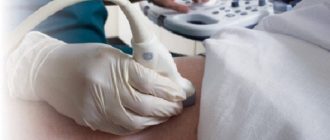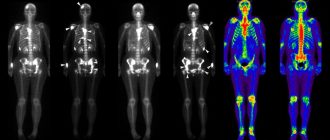Signs of chronic prostatitis on ultrasound allow the doctor to make a preliminary conclusion, but ultrasound examination does not provide the necessary accuracy. Therefore, for a final diagnosis, most often the patient needs to undergo other tests. However, ultrasound can become the primary method for determining the presence of pathologies, because its implementation is quite comfortable, compared to other methods, has a minimum of contraindications and is low in cost.
Kinds
There are several ways to conduct an ultrasound examination:
- Transabdominal (TAUS) - through the abdominal wall.
- Transurethral (TUUS) – through the urethra.
- Transrectal (TRUS) – through the anus.
- Transperineal (TPUS) – through the perineal area.
Each of these methods has advantages and disadvantages. Selected depending on indications and contraindications. Preparation for research in each method also has its own characteristics.
Indications for use
Prescribed when there are complaints about:
- frequent urge to urinate;
- painful urination;
- pain in the lower abdomen and perineum;
- inability to conceive a child;
- kidney problems.
If abnormalities are found during urine and blood tests, spermograms and other laboratory tests, a scan is also prescribed.
Ultrasound for prostatitis helps to exclude other diseases that are accompanied by similar symptoms.
Contraindications
Almost all types of ultrasound are safe and have no contraindications. Only a transrectal examination is impossible in the presence of diseases or damage to the rectum.
Preparing for the examination
Each diagnostic method requires some preparation. It includes:
- hygiene of the area being examined;
- bladder filling;
- special diet;
- taking sorbents that reduce flatulence;
- cleansing enema;
- local anesthesia
Carrying out
In order to perform an ultrasound using any of the methods, special equipment is required. Research is carried out using ultrasonic waves that penetrate organs, are reflected from them and transmitted to a special sensor. The sensor transmits readings to a monitor on which the doctor conducting the research can see changes in the organs and make a diagnosis.
To ensure accurate readings, the area through which the scan is performed is covered with a special gel that conducts ultrasound waves.
Indicators of prostatitis on ultrasound
A healthy prostate has standard indicators of size, density, and location relative to other organs. Inflammation of the prostate on ultrasound is detected if there are changes in these indicators. They help determine the extent and nature of the disease.
In addition to changes in the size and structure of the organ, the doctor pays attention to the echogenicity of the organ. Echo signs of chronic prostatitis will differ from those of adenoma or acute inflammation:
- Acute prostatitis on ultrasound looks like areas with reduced ultrasound reflection (reduced echogenicity).
- Purulent inflammation manifests itself as a combination of areas with reduced reflection and areas that do not reflect the wave.
- Sonographic signs of chronic prostatitis are characterized by increased echogenicity.
- If cysts are present, the areas will absorb ultrasound waves.
Other pathologies detected by ultrasound
An ultrasound examination of the prostate may also require scanning of other organs of the male genitourinary system - the bladder, testicles, kidneys. This is necessary because they are all closely related, and some symptoms require a comprehensive check of their condition.
The examination may reveal:
- formation of stones and sand in the prostate, kidneys, bladder;
- benign prostatic hyperplasia;
- fibrosis (replacement of functional tissue with scars due to prolonged inflammation);
- prostate cancer.
Other tests to confirm the diagnosis
Ultrasound scanning is not a highly accurate diagnostic method and is not always capable of providing sufficient accuracy to make a diagnosis. It gives only a general description of the state of the organ. To confirm the diagnosis, an additional examination is prescribed, which includes:
- Bacterial culture of prostate secretion microflora - to identify the causative agent of the disease in bacterial prostatitis.
- Microscopic examination of prostatic secretion - to compare various indicators of composition and its deviations.
- Laboratory tests of blood and urine (general, biochemistry, culture).
- Uroflowmetry (study of the urination process).
- PSA test to determine the presence of a malignant tumor.
- PCR diagnostics helps to establish the presence of a latent infection.



